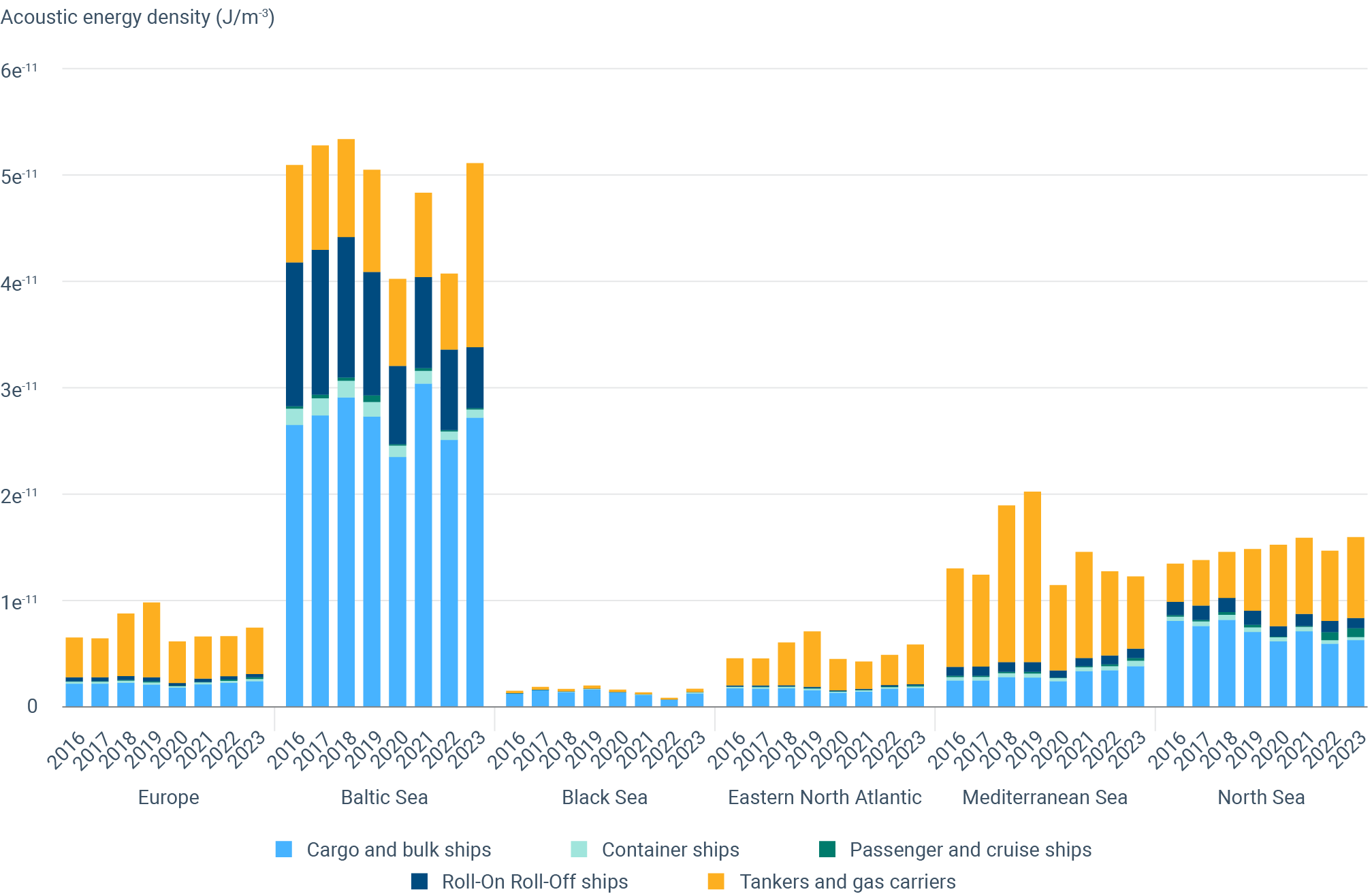All official European Union website addresses are in the europa.eu domain.
See all EU institutions and bodiesKey messages: Regional underwater radiated noise (URN) showed steady increases until 2019, followed by a sharp decline in 2020 due to COVID-19 and a gradual rise since. The Baltic Sea has the highest URN sound energy density (SED) among Europe’s seas, driven by its shallow waters and high shipping density.
Noise is one of the most widespread human‑induced pressures on the marine environment (), with ships and offshore activities causing underwater noise pollution.
Ships are the predominant source of anthropogenic, low-frequency, continuous underwater noise in oceans. One study estimates that 91% of Europe’s seas are exposed to continuous shipping noise and 10% are exposed to high shipping density . Impulsive noise from construction, seismic exploration with airguns, explosions and high‑frequency sonar systems are spatially more restricted, found in 8% of Europe’s seas.
Noise pollution can negatively affect marine life, causing behavioural and physiological changes in animals. These include increased stress, habitat loss and habitat fragmentation. This is particularly true for species already at risk of extinction . While continuous underwater noise is mainly generated all year round by commercial shipping, impulsive noise is caused by offshore oil and gas exploration (such as seismic testing and pile driving) and military activities such as sound from sonars.
Continuous underwater noise from ships can severely injure marine species. It can interfere with the critical frequency range used by various marine species for communication, hunting and self-defence, potentially masking the sounds they rely on. This is especially true for marine mammals, such as whales and dolphins, which depend on sound for communicating, finding food, attracting mates, detecting predators and navigating.
Soundscape maps are created using a state-of-the-art parametric source model that integrates ship characteristics, traffic and acoustic propagation to quantify URN across Europe’s seas. By applying a consistent approach across Europe’s entire sea basin, regions can now be compared over long time scales.
Two key parameters are used to measure URN: sound pressure level (SPL) and SED. SPL represents the spatial and temporal distribution of sound levels from sources (the soundscape). SED reflects the total sound energy in a sea region. SED is independent of the observation time window, making it useful for comparing URN across regions and identifying contributions from different ship types.
Analysing regional SED trends reveals an overall increase in URN until 2019, followed by a sharp drop in 2020 due to COVID-19 and a slight but steady increase since (though not yet returning to 2019 levels by 2023). The Baltic Sea has the highest SED due to its shallow waters and high shipping density, with cargo vessels, ro-ro ships and tankers contributing most significantly at 63Hz. In the North Sea, the southern shallow waters result in a higher SED than the deeper northern areas, leading to a lower overall average. The Mediterranean Sea's SED is dominated by tankers, which exceed all other ship types at 63Hz .
Please consult the relevant indicators and signals below for a more comprehensive overview on the topic.
Zero Pollution Action Plan 2030 target or policy objectives
- Energy, including underwater noise, is at levels that do not adversely affect the marine environment .
Return to the main pages:
Other relevant indicators and signals
References and footnotes
- ↵EEA, 2019, Navigating the course towards clean, healthy and productive seas through implementation of an ecosystem based approach, EEA Report No 17/2019, European Environment Agency (https://www.eea.europa.eu/publications/marine-messages-2/) accessed 24 October 2022.
- Tasker, M. L., 2016, ‘How might we assess and manage the effects of underwater noise on populations of marine animals?’, in: Advances in Experimental Medicine and Biology, Springer.↵
- EEA and EMSA, forthcoming, European Maritime Transport Environmental Report 2025, European Environment Agency and European Maritime Safety Agency↵
- EMSA, forthcoming, NAVISON: Calculation and analysis of shipping sound maps for all European seas from 2016 to 2050, European Maritime Safety Agency↵
- ↵EU, 2017a, Commission Decision (EU) 2017/848 of 17 May 2017 laying down criteria and methodological standards on good environmental status of marine waters and specifications and standardised methods for monitoring and assessment and repealing Decision 2010/477/EU (Text with EEA relevance) ( http://data.europa.eu/eli/dec/2017/848/oj/enghttp://data.europa.eu/eli/dec/2017/848/oj/eng), accessed 20 October 2024.



